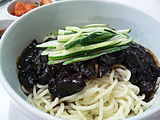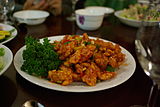- Korean Chinese cuisine
-

This article is part of the series Chinese cuisine Regional cuisinesFour Great Traditions
Cantonese • Huaiyang • Shandong • Sichuan
Eight Great Traditions
Anhui • Cantonese • Fujian • Hunan • Jiangsu • Shandong • Sichuan • ZhejiangBeijing and the vicinity
Beijing • Imperial • Aristocrat • TianjinOther regional styles
Chaozhou • Guizhou • Hainan • Hakka • Henan • Hong Kong • Hubei • Jiangxi • Macanese • Manchu • Northeastern • Shaanxi • Shanghai • Shanxi • Taiwanese • Xinjiang • Tibetan (Xizang) • YunnanReligious cuisinesBuddhist • IslamicIngredients and types of food China portal
China portalKorean Chinese cuisine (Korean: Junghwa yori; hangul: 중화요리, hanja: 中華料理) is derived from traditional Chinese cuisine but has been influenced by local ingredients in Korea. Due to geographical proximity, most Korean-Chinese dishes are derived from Northern styles of Chinese cuisine such as Beijing and Shandong cuisine. However, some have regarded Korean Chinese cuisine as being more Korean than Chinese. The cuisine developed in the port city of Incheon, where the majority of Korea's ethnic Chinese population historically lived. However, Chinese restaurants in Korea are unusual in that they are owned and run by Koreans, rather than ethnic Chinese. The latter development came in part due to the assimilation of the ethnic Chinese in Korea into the Korean culture as well as due to their outward migration due to legal discrimination they were subject to, especially under the Park Chung-hee administration. Consequently, the most authentic Korean Chinese cuisine can be found in centers of overseas Korean communities such as Queens[1] and Manhattan in New York City; Palisades Park, New Jersey; as well as Los Angeles, all in the United States.
In South Korea there is an aspect of this cuisine which is unusual, in that home delivery is the main means through which it is put in front of diners. As such Korean Chinese cuisine is analogous to pizza delivery in the US or Indian take-away in the UK, and every S Korean urban household is served by no fewer than two such establishments. The cuisine also occupies the same economic position to the two a-fore mentioned analogues, in terms of relative pricing vis-a-vis other dining options. Expensive gourmet Chinese cuisine at upscale establishments dedicated to such is also popular in South Korea, but the cuisine served is mainland Chinese styles.
Korean-Chinese dishes
There are two primary Chinese menu items served in the majority of Korean Chinese restaurants in South Korea and elsewhere:
- Jajangmyeon (Korean: 자장면, Chinese: 炸醬麵), steamed noodles served in a lightly flavoured black bean paste, distinctly different from the various types of zhajiang mian served in mainland China and Taiwan.
- Jjamppong (Korean: 짬뽕, Chinese name: 炒碼麵), a spicy noodle soup flavoured with onions and chili oil. A form of jjamppong is also the local Chinese speciality in the Japanese port city of Nagasaki (see Chanpon). The noodles are made from wheat flour.
In addition, several other dishes are often served in Korean Chinese restaurants:
- Tangsuyuk (Korean: 탕수육, Chinese: 糖水肉), the Koreanized version of sweet and sour pork or orange chicken.[2] Unlike the Americanized Chinese dish of the same name, tangsuyuk can be made with either pork or beef. If the meat is replaced with shrimp, the dish is called tangsu saeu.
- Kkanpunggi (Korean: 깐풍기, Chinese: 宫爆鸡), a type of fried chicken glazed in sweet and spicy sauce. It can be served with the bone or boneless.
- Kkanpung saeu (Korean: 깐풍새우), deep-fried breaded sweet and sour shrimp with a bit of hot and spicy flavor unlike tangsuyuk and tangsu saeu. It is different from Kung Pao shrimp served in typical Chinese restaurants because kkanpung saeu is breaded and deep fried, as opposed to stir-fried. It is served with a sweet sauce, peas, carrots, green onions, and red chili peppers.
- Ulmyeon (Korean: 울면), similar to Udon, is a dish consisting of wheat flour noodles, chopped vegetables, and seafood in a chowder-like broth that is thickened with cornstarch. It is derived from a Chinese dish called wēnlŭmiàn (溫滷麵). [1]
- Jajangbap (Korean: 자장밥), similar to jajangmyeon but served on steamed rice. It may also be served with a fried egg and some vegetables.
- Junghwa naengmyeon (Korean: 중화냉면, Chinese: 中華冷麵), literally "Chinese cold noodles." It is favored in Chinese restaurants in South Korea during the summer. Junghwa naengmyeon is made with junghwamyeon (lit. "Chinese noodles"), shredded five-spice marinated beef or pork (五香醬肉), cucumber, crab stick, jellyfish, and a fried egg in a cold chicken broth seasoned with soy sauce and various spices. A sauce mixed with mustard and peanut sauce is topped over the dish to impart a nutty and spicy flavor.[3]
Dumplings are also served at Korean-Chinese restaurants, in most instances a pan-fried version that is a cross between a Japanese gyoza and a Peking ravioli in terms of style.
Koreans traditionally eat Chinese food with a side serving of danmuji (yellow pickled daikon), and raw onion dipped in black bean paste. Kimchi, a staple Korean food, is also eaten with Chinese food. Dried red chili flakes are provided to season food alone or mixed with soy sauce.
See also
- Japanese Chinese cuisine
- Chinatown, Flushing
- Koreatown, Palisades Park
References
- ^ Julia Moskin (2008-07-30). "Let the Meals Begin: Finding Beijing in Flushing". The New York Times. http://www.nytimes.com/2008/07/30/dining/30flushing.html?pagewanted=2. Retrieved 2011-06-26.
- ^ Gang, Gi-seok (강기석), (2009-11-01) (영피플&뉴앵글) 미국식 자장면· 짬뽕 Asia Gyeongju
- ^ Seo, Won-ye (서원예), (2009-06-12)냉면만 먹자니 지겹죠…색다른 '여름麵' 어때요 (in Korean), Hankguk Gyeongju
Categories:- Chinese cuisine
- Korean cuisine
- Chinese cuisine stubs
- Korean cuisine stubs
Wikimedia Foundation. 2010.



